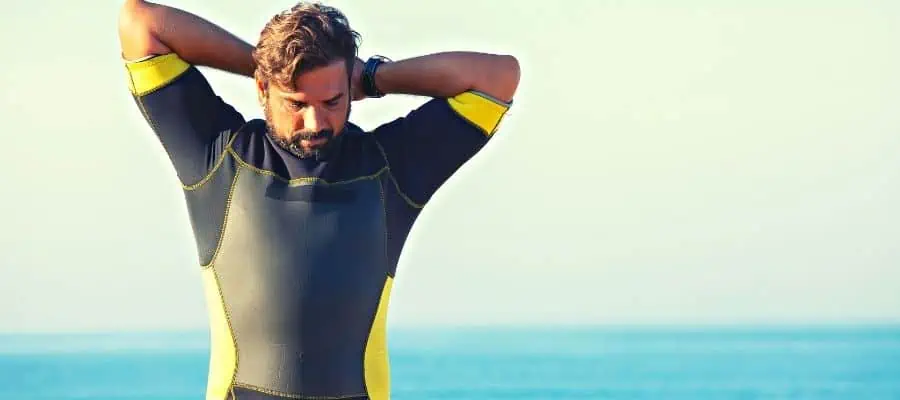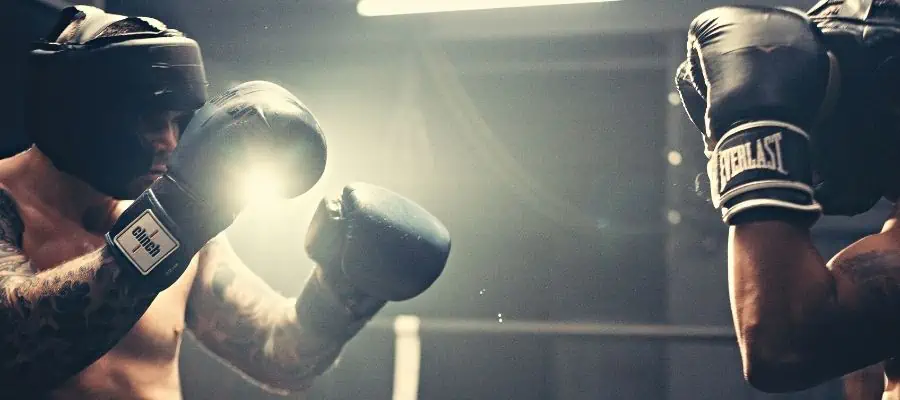It’s no secret that shadow boxing in martial arts such as boxing, Thai boxing, etc., is one of the most important training parts. It improves attack and defense combinations, as well as speed and explosive power. But how shadow boxing in the water can help a fighter?
In general, shadow boxing in water is a harder version of normal shadow boxing. Except here the water density creates a specific obstacle for the boxer and makes the exercise more difficult. Water will help to increase punching speed, explosive power, and accuracy of the technique. If you train with your head under the water, you can increase your lung capacity. It will help to improve your breathing during the fight.
The structure of the water makes some of the athlete’s movements harder and some easier. Water is the ideal place for alternative training. Thus, for both amateurs and pros, training in a pool, etc. will give extra results.
Who Else Can Benefit From Training In Water

Many millions of people are already trained in the water. Whether it’s swimming, water dancing, or rhythmic gymnastics. They use water every day to improve their health and skills. Programs with names like Aquatics or Hydro Fitness have long been popular.
Almost any public pool offers at least one program, and many pools have many students. These training programs are especially suitable for older people. Some of the standard forms of fitness (running, cycling, aerobics, etc.) are too difficult for them.
But water exercises are good for them because the load on the body joints is very low. Athletes after injuries can also benefit from water exercise. This will put less load on joints and muscles and speed up recovery. It is possible to perform recovery exercises with the constant resistance of the water, without the risk of injury.
Water has two main functions for the body. Body resistance and support. This makes it excellent equipment and almost perfect training space for practicing technique variations. The density of water makes most movements more difficult than in the open air. A simple step that requires less effort on land takes 1.5 to 2 times more energy in the water.
Even if we try to do it as fast as possible. Try running from one end of the pool to the other. It is much harder than when you run on land, and the running is much slower. Because you are not only running in the pool, but you are also trying to move your body by overcoming the resistance of the water.
The resistance of water is always constant. This is not like training with dumbbells. There the resistance changes depending on the direction in which the force is applied. The resistance of the water remains constant for the entire movement. You can see from movies and many videos on the Internet that in the water you can perfectly work out the kicks.
It is recommended to do shadow boxing from the beginning being in the water up to your ankles. In this way, the footwork will be improved. If it’s easy, go into the water waist-deep. For advanced athletes, the body is dipped to shoulder level. Here the load will go to the whole body.
At the most advanced level, the body is completely immersed under the water. At depth, shadow boxing additionally turns into a struggle to stay underwater. The water by its nature will try to push you to the surface, so you work almost without any rest.
If you combine shadow boxing in the water with shadow boxing on land, you’ll immediately feel more speed on land.
Why Do Boxers Train Underwater

Many boxers use the underwater training method because of its effectiveness. With water, the load on the body increases significantly. So, it becomes quite difficult to perform normal exercises. Thanks to this, the boxer improves his endurance and speed.
Besides, underwater training puts the boxer training in uncomfortable conditions. Because he has to hold his breath and fight with the water so it doesn’t push him to the surface. First, it is important to note that it is not necessary to be fully immersed in the water for shadow boxing.
Full head immersion is the most difficult exercise. It should be performed with minimal time and gradually try to increase the time spent under the water.
Shadow Boxing In The Water About Knee-deep

In this exercise, a lot of attention is paid to the footwork. The idea is that the water resistance is not very strong and allows us to move in the water along with shadow boxing. Besides, not very strong resistance will help to improve leg balance and speed.
Depending on the workout, the water level can be lowered to the ankles or raised 10 centimeters above the knees.
Shadow Boxing In The Water Up To The Neck

In this exercise, the footwork moves into the background, and the focus moves to punch. The boxer immerses himself in the water to a level just below his shoulders. Then he begins to throw different combinations of punches. For stronger resistance, you can use, for example, a plaster trowel.
By punching we kind of push our punches through the water. In this case, a plaster trowel will expand the resistance range and increase the exercise’s difficulty.
Shadow Boxing Under The Water

This exercise is the most difficult for two reasons:
Lack Of Breathing
Usually, when we hit, we breathe, and we breathe pretty hard. This means that when we hit, we make a strong breath out. Accordingly, it becomes very difficult to execute 4,5,6 punches underwater, and so we need to constantly dive out to breathe in.
Besides, breath-holding is useful for the development of endurance, as the body learns to use as little oxygen as possible. This will help us to stay in good condition longer in the fight.
Water Resistance
As I wrote above, the fact that we take a lungful of air to practice shadow-boxing underwater prevents us from staying at the bottom of a pool. This is because water, by its nature, pushes air to the surface. Accordingly, you will frequently resurface.
Performing this exercise will be even more difficult if you have to spend some energy to stabilize your body underwater. In this exercise is that the athlete must try to execute the largest possible number of punches underwater. He must stand firmly on the bottom while keeping the correct stance and punching technique.
Swimming or techniques improvement in the water withholding your breath is also necessary. By technique, improvement can be done in water or fully immersed as well. Instead of performing shadowboxing underwater, you can swim underwater.
Do it for as long as possible. For example, during a round do shadow boxing for 20 seconds and then swim underwater. After that again shadow boxing for 20 seconds etc. You can do these exercises in the water as many times as you like, the main thing is to take care of your health and safety.
If you are not exercising in a pool, it is important to make sure that there are no stones or protruding sticks at the bottom of the river.
Does Swimming Help Fighters

In general, swimming in different styles is extremely important for boxers. Smooth movements and rhythmic breathing develop the ability to relax and tense muscles. They develop the rib cage and develop movement flexibility. Besides, swimming has a great hygienic and health value.
It has a calming effect on the nervous system. It is recommended to go swimming after main boxing training or after general physical preparation (GPP) workout. Swimming will serve as a way to recover from heavy loads during all periods of training.
Benefits Of Swimming

Cardio Exercise
The water density is much higher than the air density. This means that the athlete will feel more resistance while swimming. This means he will have to spend more energy to overcome it. So, your endurance will be improved by swimming.
General Physical Preparation (GPP)
Swimming is a natural activity, inherent in us by nature itself. It involves the biggest number of muscle groups working at the same time. Compared to running, swimming involves many more stabilizer muscles. They regulate the movement direction and keep our body afloat.
Health Benefits
It is a perfect exercise for keeping the spine and musculoskeletal system healthy. It also improves body posture and even helps in recovery after injuries. As the body cuts across the water surface, the swimmer keeps the respiratory organs like the nose, and mouth instinctively above the water level.
To do this, the back and neck muscles stretch and strain the entire spinal column.
Coordination
A fighter’s vestibular system goes through a real roller coaster during a fight. Being in the water improves the athlete’s sense of body control. This is the best way to train the ability to not confuse the floor with the ceiling after falling on the mats.
Breathing
During swimming, the rib cage gets extra water pressure from the outside. This means that the intercostal muscles and diaphragm work at an increased capacity. It helps to develop breathing endurance
Conclusion
Swimming training can be done as a full workout or as a warm-up or relaxation exercise. It all depends on the task you have set. And if you combine swimming with other workouts, do not forget that the body does not always have to work at its full capacity.
So I would advise you to do a swimming workout once a week just for relaxation and recovery. Swim not longer than half an hour and not too intensively, but freely and relaxed. Remember that there should be a balance in everything, and the load should be increased gradually.
If you decide to add swimming to your workouts, start slowly so as not to overtrain your body.
I hope this article was helpful to you. Good luck in boxing and swimming.
Recent Posts
What is Manachai's Fighting Style? Unveiling Muay Thai Mastery
Manachai, a celebrated figure in the Muay Thai world, has captivated audiences with his exemplary martial prowess. Hailing from the heartlands of Thailand, his name is synonymous with the art of...
What Was Chamuekpet Hapalang's Fighting Style? Unveiling Techniques
Chamuekpet Hapalang was a renowned figure in the world of Muay Thai (record 200-48-2), embodying a fusion of Muay Bouk and Muay Khao styles. Originating from Thailand, the art of Muay Thai is known...
